


Dr. Babasaheb Ambedkar had declared in 1935 that although he was born as a Hindu he would not die as one, as conversion was the solution to abandon the caste system. After this declaration, he extensively studied the doctrines of all the major religions to choose Buddhism for himself and his followers.
Buddhism was 2,550 years old in 1956, so it was notable year for global celebration and 14 October was the traditional date of conversion of greatest Buddhist King, Ashoka Maurya, the celebration of Ashok Vijaya Dashmi. He selected Nagpur for his conversion ceremony, as he explained in his speech at that occasion, because Nagpur was the homeland of ‘Nag’ people who embraced Buddhism, supported it with great efforts in its early period, and propagated it throughout India. Ground near the Ramdaspeth area in Nagpur was selected for the ceremony.
On 14 October 1956, Dr. Babasaheb Ambedkar and his wife took the oath of Three Jewels and Five Precepts from the Burmese monk Mahasthavir Chandramani from Kushinagar. Dr. Babasaheb Ambedkar then gave the oath of Three Jewels, Five Precepts, and 22 Vows to his thousands of followers. In this way, Nagpur became the birthplace of Neo Buddhist movement.
Dr. Babasaheb Ambedkar Ambedkar died on 6 December 1956, one and a half months after the Deeksha ceremony. However, this ceremonial conversion continued after his death, converting 15-20 million by March 1959. After his death the ‘Param Pooja Dr. Ambedkar Smarak Samiti’ (Dr. Ambedkar Memorial committee) was organized for the management of Deekshabhoomi. The committee decided to build a stupa at the place as a monument of that ceremony and a mass conversion of people to Buddhism.


The geographical land spreads over 22 acres, covered with lush green beautification. The central part is dedicated for the giant stupa. Sheo Dan Mal, a famous architecture in Nagpur was handed over the responsibility to design a befitting structure of the stupa. He studied the Buddhist architecture around the world for more than two years and came up with a glorified design that reflects the teachings of the Buddha.
The construction began in July 1978 and for the first time in Asia Central Block Locking System in constructing a hollow globe-like structure (the uppermost half part of the stupa) was used. It has a diameter of 120 sq.ft. More than 5000 people can be accommodated at once at this floor of 211 x 211 sq.mtrs. Sheo Dan Mal was the pioneer for this kind of innovation in structuring. The stupa is supported by four expanding arrangement of 16 columns at the first, 16 columns at the second, 24 at the third and the last layer of 24 columns again. The ground floor has a space of more than 20000 sq.ft. and is meant for offering prayer.

At the central part, another glass structure is founded on a marble square. There is kept a silver vessel polished with gold (Asthikalash) where the mortal remains of Dr. Babasaheb Ambedkar are preserved. The vessel originally was with the People’s Education Society, Mumbai and later handed over to the Samiti on 07th October 1981. In a splendor-some religious ceremony the mortal remains were instituted on 02nd October 2001. Besides that there are two statues of Lord Buddha donated to Samiti (on 25th February 1996) by Bhante Sawang and students from Thailand. The inaugural programme was held on 02nd October 2001 in the august presence of Bhante Arya Nagarjun Surai Sasai.
The stupa has four gates (part of stupa), similar in structuring again and they are mounted with images of Dhammachakra, horses, elephants, lions carved in Rajasthani marble followed after the stupa at Sanchi. It is a unique combination of the ancient and modern architectural features. It stretches a path opening towards the civic roads in four different directions. The space in between is decorated with green plantation and palm trees.

At the main entrance for tourists there is a book stall and security check-post.
At the eastern side, there is a Bodhi Tree, Bhikkhu Niwasa, a column in marble of 22 vows, Preamble of the Constitution of India.
The western side of the stupa is an open ground kept reserved for public programmes on the day of Dhammachakra Pravattan Din. A minor part is given for Dr. Ambedkar Sports Academy, Dr. Ambedkar Law College and Dr. Ambedkar Institute of Management Studies and Research and public amenities.
The north of deekshabhoomi has Dr. Ambedkar College run by the Samiti. It is a multi-faculty educational institution offering Arts, Commerce and Science streams.
The southern entrance is decorated with high stretching palm trees.
At the eastern part of the geography, there is a Bodhi Tree with its widest branches now supported with iron bars at ground.
Three branches of the Bodhi Tree at Anuradhapura (Sri Lanka) were requested officially to the Government of Sri Lanka and were brought to Deekshabhoomi by Bhadant Anand Kausalyayan, Bhadant Dr. Hampolo Ratansara and Bhadant Aanandmangal. The saplings were taken from the same Bodhi Tree planted by Sanghamitra, daughter of the Great Emperor Asoka, during her monkhood (253 B. C.). The Bodhi Tree in Sri Lanka was originally a sapling from the bodhivriksha under which the Buddha became enlightened.
Each Bhante planted those three saplings at the same place.
In a formal ceremony on 12th May 1968 (Vaishakh Bouddha Pournima) those three saplings were planted. The present Bodhi Tree at deekshabhoomi today is an intact combination of these three sapling now appearing as one. The President of this function was Padmashri Dadasaheb Gaikwad.
Beside the Bodhi Tree, there is another establishment known as Bhikkhu Niwas. It was initiated by Bhadant Anand Kausalyayan and built by the Samiti in 1968. Inside Bhikkhu Niwasa, there is a magnificent statue of Lord Buddha presented by Thai Monastery, established in a religious ceremony at the dignified hands of Sirparesh, High-Commissioner, Government of Sri Lanka.
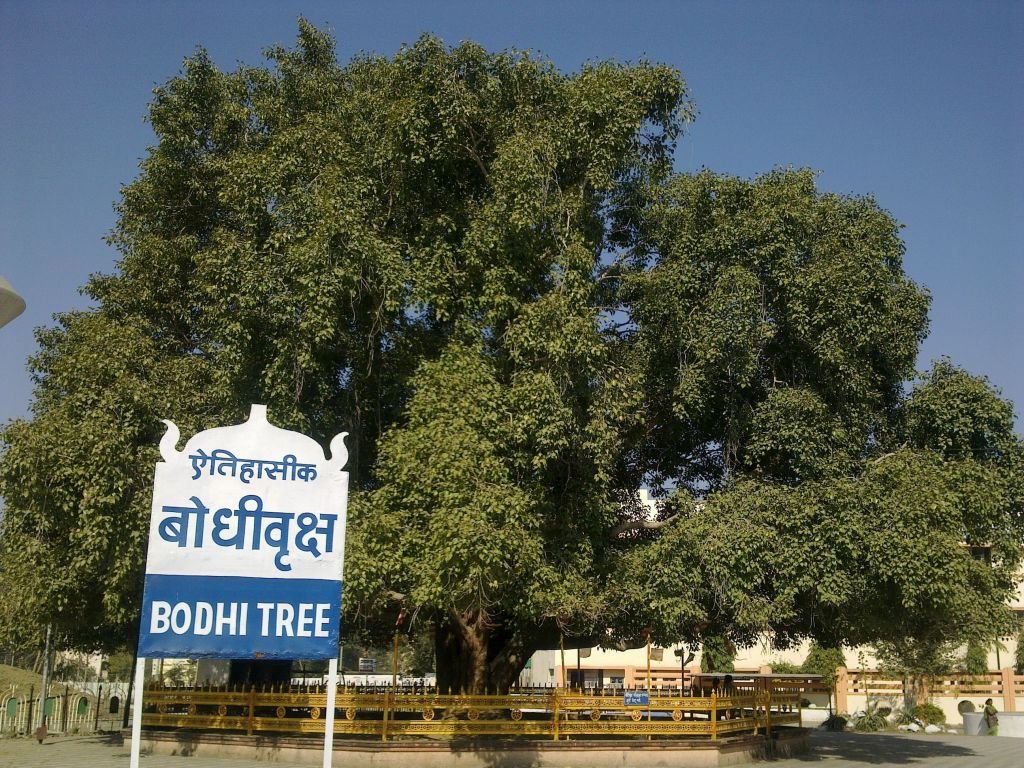
Bodhi tree
The Smarak Samiti conducts a number of programmes wherein the most popular and mega event is Dhammachakkra Pravartan Din that falls in October. Not only across the country from around the globe there are visitors to Deekshabhoomi, the central memorial of Dr. Babasaheb Ambedkar at Deekshabhoomi. Millions of people who follow the very Buddhist way of life and Dr. Babasaheb Ambedkar come to this place to pay their rich tributes. The most notable aspect of the whole event is that it is primarily organised by the Samiti and supported equally by local civic authorities. The biggest ever congregation is but realised in a peaceful manner and that creates a unique example of Buddha’s teachings-the peaceful and moral way of life.
Since the foundation stone was laid for the magnificent construction of the Stupa, various super-dignitaries have visited the place and offered their respects to the mortal remains of Dr. Babasaheb Ambedkar kept at the central place of the Stupa. They includes Prime Ministers, Presidents, Ministers of different states and others.
More than a hundred book-stalls from local and national level publishers sell thousands of books and perhaps receive a surprising turnover of crores of rupees. It is a distinguished event in that case for Deekshabhoomi is the only place wherein people buy books at this extent rather than anything else.
Parallel to this, the Samiti organises Dhamma Diksha Samaroh where people belonging to different religions and sects embrace Buddhism. The Samiti facilitates this programme right in advance to the actual event and diksha is given at the hands of revered Bhikkhusangha led by Bhadant Arya Nagarjun Surei Sasai. It continues for almost a week and the converted are given certificate by Samiti so as to recognise the conversion.
To add more of academic value in addition to the religious one, learned professors, social activists and researchers in Buddhism are respectfully invited as resource persons for at least a dozen of conferences and seminars on thematic aspects of Buddhist Studies, literature, Life and Philosophy of Dr. Babasaheb Ambedkar.
Many other programmes separately arranged by social organisations are supported by the Samiti throughout a year wherein they are provided free space and other physical infrastructure.
Most of the facilitation such as food, sanitation, medical aid, shelter, travel is arranged by hundreds of social organisations run by locales, employees and state and central government officers. The green city joins hands to ensure that all the events are run smoothly and without any fault at any level.
Programmes of popular awareness regarding the Buddha’s teachings; life and works of Dr. Babasaheb Ambedkar are conducted in the form of street-plays, finished theatrical plays, movies, documentaries and local as well as professional singers. This mega event is monitored by the Samiti with all its members and voluntary organisations in support.
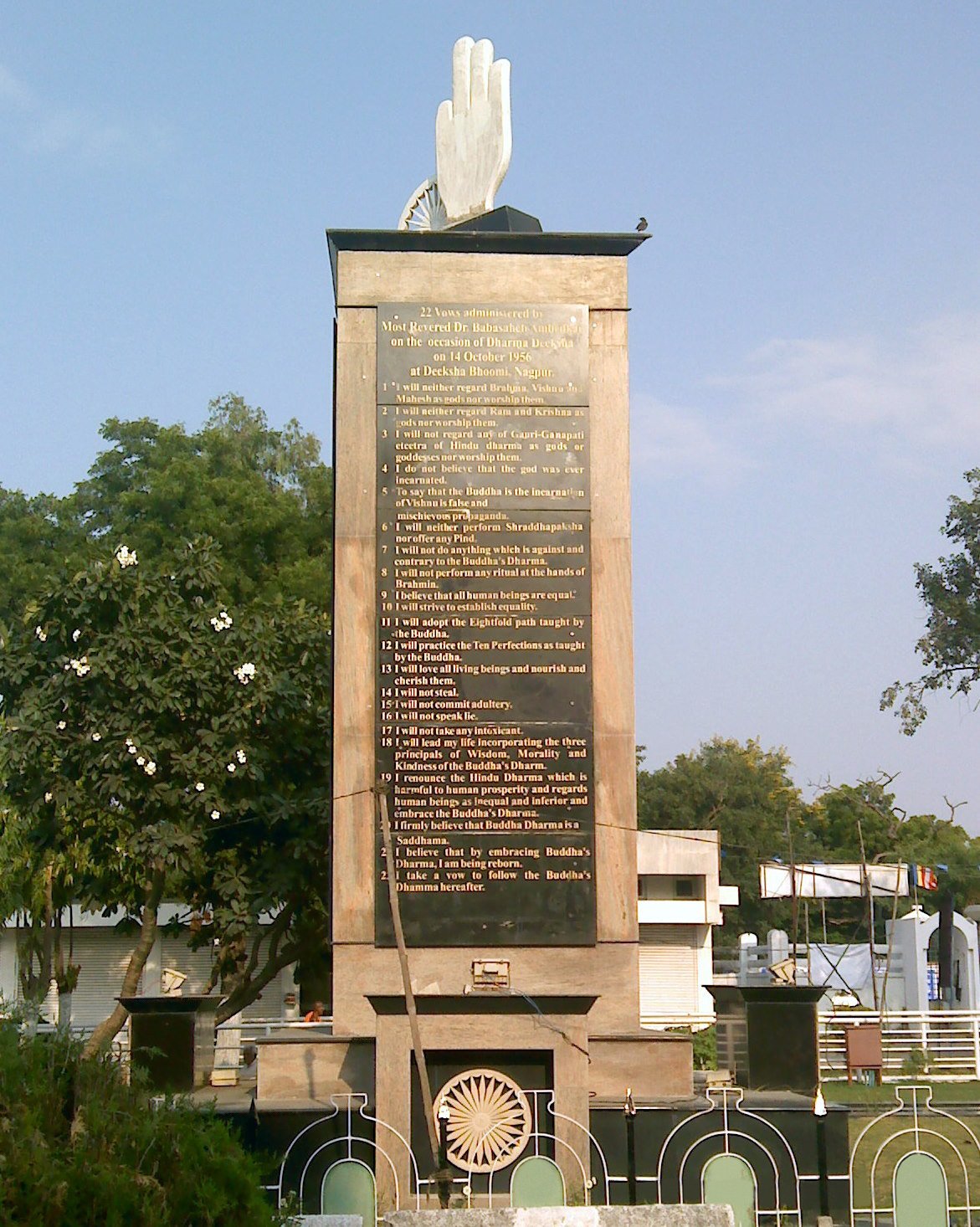
Twenty two vows of Buddhism by Dr. Ambedkar at Deekshabhoomi
Taking into consideration the academic stature of Dr.Babasaheb Ambedkar, the Samiti decided to have a befitting approach to realise the educational vision. It is with this the institution was established in 1964. It should be mentioned here that through all these years thousands of students belonging to socio-economically backward areas have received the benefits of quality education and have placed themselves at superior positions.
The College runs multi-faculty higher educational facilities and has been recognised twice at ‘A’ Grade by the National Assessment and Accreditation Committee. The college is moving for the third cycle of accreditation. The college offers education in Arts, Commerce and Science faculty. To facilitate further opportunities in higher learning at the same place, the undergraduate courses are supported with post graduate courses in humanities and basic sciences. A very dedicates staff and updated laboratories for every separate subject and specialisation, the college has been progressing leaps and bounds.
The college arranges various special programmes in the interest of students and makes sure that every students get equal benefit of all the facilities available in the campus. There are guest lectures, exhibitions, special courses of add-on kind and cultural events are the aspects the college feels proud about.
Education in Law was started in 1984 and it has been recognised as the best law school in the vicinity. There are students made into professionals with a positive approach towards upliftment of social undertakings. Post graduate course in Law was started in 2013 and it is equally popular for advanced studies with several specialisations.
With a vision to develop a centre of excellence for value-based management education and research through commitment and continuous learning, strategically partner the industry and be conscious to societal responsiveness this institute was established in 1987, this institution has been known for its excellent quality education for management professionals as well the finest placement of students. It is listed as one of those few colleges where superiority of educational atmosphere is maintained without compromising anything. Students’ academic interests are protected and they are facilitated to grow further with every advanced preparation with in-house trainings.
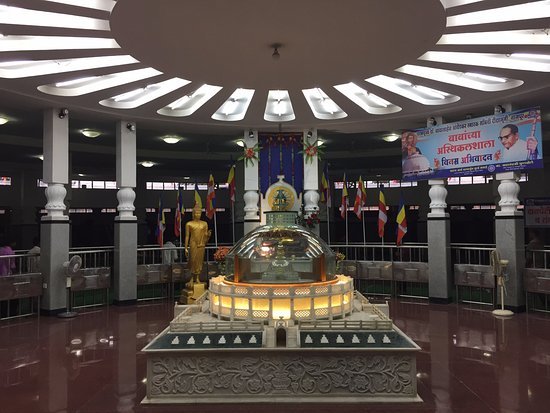
Sacred place inside deekshabhoomi
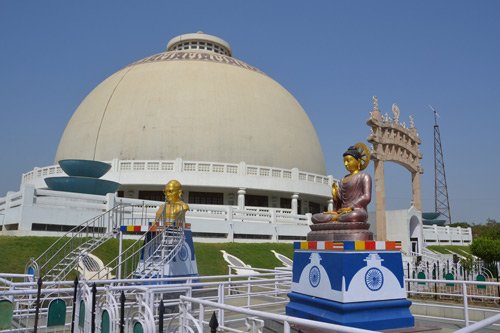
Buddha and Ambedkar statue outside of deekshabhoomi
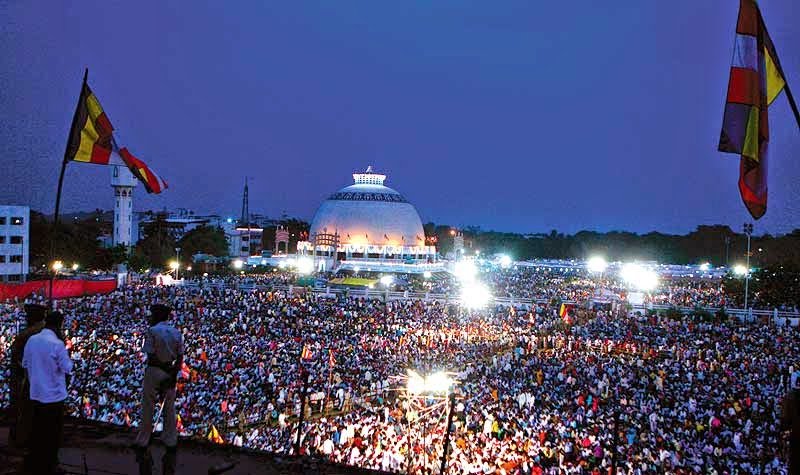
Vijayadashmi and Dhamma Chakra Pravartan din at deekshabhoomi